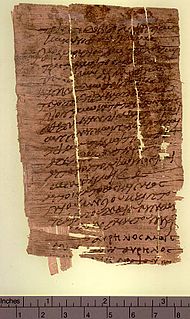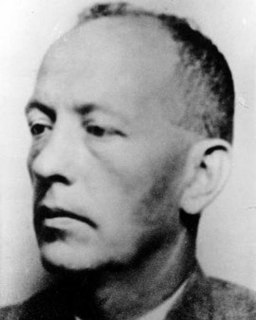 W
WA martyr is a person who was killed because of their testimony of Jesus and God. In years of the early church, this often occurred through death by sawing, stoning, crucifixion, burning at the stake or other forms of torture and capital punishment. The word "martyr" comes from the Koine word -> μάρτυς, mártys, which means "witness" or "testimony".
 W
WA libellus in the Roman Empire was any brief document written on individual pages, particularly official documents issued by governmental authorities.
 W
WRaphael, Nicholas and Irene of Lesbos are venerated as saints and "new martyrs" in the Orthodox Church. According to a 20th-century legend, they lived on the island of Lesbos in the 15th century and were killed by Turkish raiders in April 1463. Raphael is said to have been the abbot of a monastery of Karyes, near the village of Thermi, Nicholas a deacon in the same monastery, and Irene the 12-year-old daughter of the local mayor.
 W
WSaint Agathoclia is venerated as a patron saint of Mequinenza, Aragón, Spain. Her feast day is September 17.
 W
WSaint Blandina was a Christian martyr who died in Lyon, France during the reign of Emperor Marcus Aurelius.
 W
WSaint John de Britto, also known as Arul Anandar, was a Portuguese Jesuit missionary and martyr, often called 'the Portuguese St Francis Xavier' by Indian Catholics. He can be called the John the Baptist of India.
 W
WCallistratus of Carthage and his forty-nine companions were Christian martyrs executed at Rome during the Diocletianic persecution (303–311) now commemorated as saints in the Roman Catholic and Eastern Orthodox churches. Their hagiography, known from the compilation of Symeon the Metaphrast, contains fantastic elements.
 W
WElias of Heliopolis (759–779), also called Elias of Damascus, was a Syrian carpenter and Christian martyr revered as a saint in the Eastern Orthodox and Syriac Orthodox churches. He is known from a Greek hagiography.
 W
WFelicitas of Rome, also anglicized as Felicity, is a saint numbered among the Christian martyrs. Apart from her name, the only thing known for certain about this martyr is that she was buried in the Cemetery of Maximus, on the Via Salaria on a 23 November. However, a legend presents her as the mother of the seven martyrs whose feast is celebrated on 10 July. The Eastern Orthodox Church celebrates their martyrdom on 25 January.
 W
WFrancis Hong Yong-ho was a Roman Catholic prelate in North Korea who was imprisoned by the communist regime of Kim Il-sung in 1949 and later disappeared. After his disappearance, he was for many years listed as the Bishop of Pyongyang.
 W
WFranz Leuninger was a German trade unionist, politician and resistant against the Nazis' rise to power and regime. Working as a bricklayer after school, he became a member of the trade union for construction workers early on, serving as its regional leader in Silesia in the 1920s. He was a member of the city council of Breslau for the Zentrumspartei from 1930, and ran for the German Reichstag in 1933, as a strong opponent of the Nazi party.
 W
WMartina of Rome was a Roman martyr under emperor Alexander Severus. A patron saint of Rome, she was martyred in 226, according to some authorities, more probably in 228, under the pontificate of Pope Urban I, according to others. Her feast day is January 30.
 W
WNayrouz or Neyrouz is a feast when martyrs and confessors are commemorated within the Coptic Orthodox Church. Celebrated on September 11, the day is both the start of the Coptic new year and its first month, Thout.
 W
WPerpetua and Felicity were Christian martyrs of the 3rd century. Vibia Perpetua was a married noblewoman, said to have been 22 years old at the time of her death, and mother of an infant she was nursing. Felicity, a slave imprisoned with her and pregnant at the time, was martyred with her. They were put to death along with others at Carthage in the Roman province of Africa.
 W
WSaint Reparata was a Catholic virgin and martyr of the 3rd century AD, of Caesarea, Roman Province of Palestine. Sources record her age as being from 11 to 20 years old, though Sainte-Réparate Cathedrale in Nice gives it as 15 years. She was arrested for her faith and tortured during the persecution of Roman Emperor Decius.
 W
WSophia, also spelled Sofia, is a feminine given name, from Greek Σοφία, Sophía, "Wisdom". Diminutive forms include Sophie and Sofie. The given name is first recorded in the beginning of the 4th century. It is a common female name in the Eastern Orthodox countries. It became very popular in the West beginning in the later 1990s and became one of the most popularly given girls' names in the Western world during the 2010s.
 W
WStephen, traditionally venerated as the protomartyr or first martyr of Christianity, was, according to the Acts of the Apostles, a deacon in the early church at Jerusalem who aroused the enmity of members of various synagogues by his teachings. Accused of blasphemy at his trial, he made a speech denouncing the Jewish authorities who were sitting in judgment on him and was then stoned to death. His martyrdom was witnessed by Saul of Tarsus, also known as Paul, a Pharisee and Roman citizen who would later become a Christian apostle.
 W
WTheodore the Martyr was the name of a number of Christian saints. Two of the best known, Theodore of Amasea and Theodore Stratelates, were probably the same person. A variety of stories are told about Theodore the Martyr. Relics of Theodore the Martyr, including at least four bodies as well as body parts, were taken to Venice, where he is one of the patron saints, or to other places in Western Europe.
 W
WThis is a list of Christian women in the patristic age who had roles in the development of the early Christian churches and communities. Many of these women were examples of piety for both men and women in the Church. Some of these are also martyrs and saints. The patristic era is considered to have started at the end of the 1st century and to have ended towards the close of the 7th century.